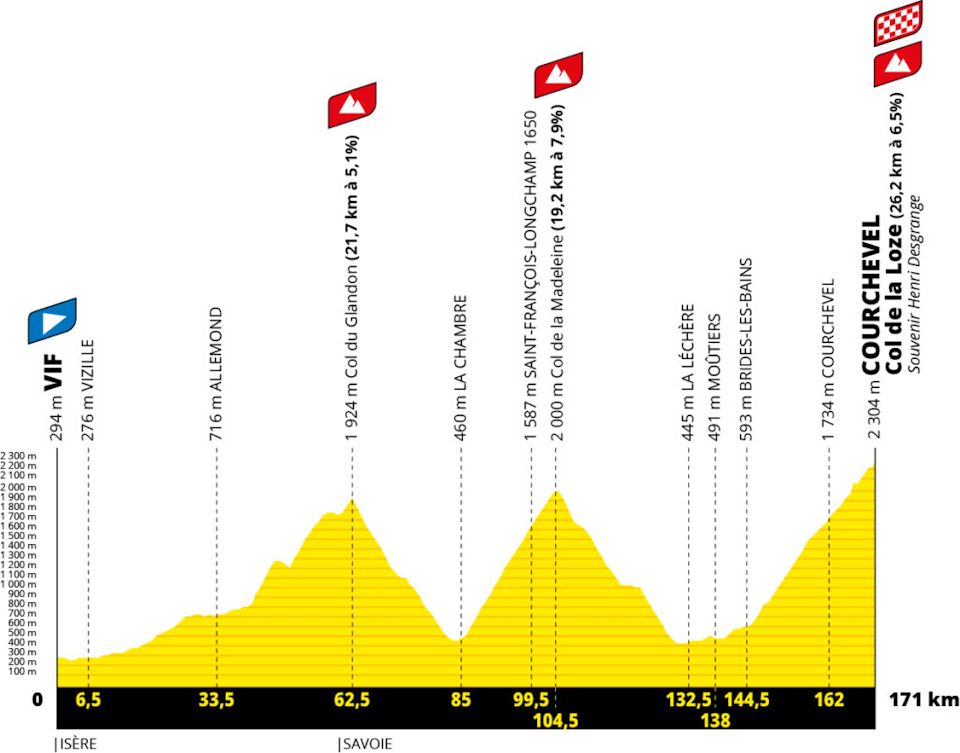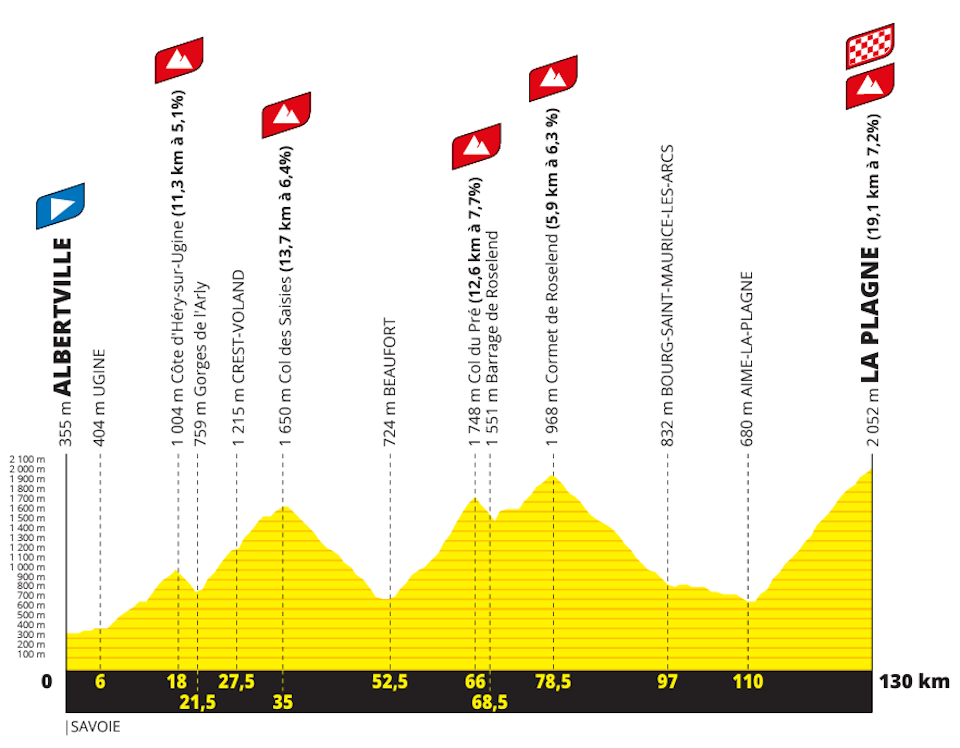7 Must Watch Stages of the 2025 Tour de France
Five summit finishes, an uphill time trial in the Pyrenees, the Col de la Loze in reverse, the return of Mont Ventoux and a traditional Paris finale all feature in the route of the 2025 Tour de France

The 2025 Tour de France, the biggest professional bike race in the world, runs from July 5 to 27, covering 21 stages and a total of 3,350 kilometers with 51,550 meters of climbing. The 21 stages include; 7 flat stages, 6 hilly stages, 6 mountain stages with 5 mountain top finishes, and 2 time trials.
The 112th edition, which will start in Lille and take place entirely within the confines of France, will pay tribute to all-time French cycling greats, from Jean Robic and Louison Bobet to Jacques Anquetil, Bernard Hinault and Laurent Fignon. The 2025 edition will also mark the fiftieth anniversary of the polka-dot jersey, the best young rider classification and the first finish of the race on the Champs-Élysées in Paris.
In the second week, the riders will face the Pyrenees and iconic climbs like Luchon-Superbagnères and the Tourmalet. The final week features summit finishes on Mont Ventoux and in the Alps. The 112th edition of the Tour de France wraps up with the final stage back on the streets of Paris, ending with a final flat-out sprint up the Champs-Élysées.
1) Stage 7 - Double Trouble on the Mûr-de-Bretagne
The Grand Boucle kicks off in Lille in northern France. After a first week packed with sprint stages, classic routes, and a 33km time trial, the peloton hits the Massif Central just before the rest day as double helping of the Mûr-de-Bretagne steals the show.
Just like 2021 when Mathieu van der Poel won here, the race will go up to cross the line then make a small loop before charging back up for the finish.

A mountain stage on Bastille Day is set to be explosive with seven second-category climbs on the agenda on Stage 10. An ascent of Puy de Dôme, features early in the stage. Riders will face continuous challenges up to the final ascent to Le Mont-Dore. The concluding 3.5km climb, with an average gradient of 8%, culminates in a total elevation gain of 4,400 metres for the day.
2) Stage 12 to Hautacam
One day later, the route takes the peloton into the Pyrenees. First up is a stage finishing at the summit of Hautacam where the GC contenders will want to make their mark on the race.
Whenever the Tour de France enters the Pyrenees, it's bound to be a pivotal day. The fight among the GC contenders will intensify, especially over the last 45 kilometers.
There’s 3,850m of vertical gain after the dash across the plains to the Col du Soulor and then crossing over to the backroad Col des Bordères for some added elevation and a narrow descent. Then comes Hautacam, a sustained climb that will take close to 40 minutes even for the best, on the 13.6km climb which has an average gradient of 7.8%.
For those concerned about a dominant performance by Pogacar, Hautacam is notable as the location where Vingegaard decisively strengthened his lead during his first Tour victory over the Slovenian in 2022.

Hautacam is followed by an 11-kilometer mountain time trial to the Altiport of Peyragudes. GC contenders can gain or lose time on their rivals and we should see the first gaps overall.
3) Stage 14 to Luchon-Superbagnères
Stage 14 is a classic: the Toumalet, Aspin and Peyresourde. That would be plenty but the race returns to the Col du Treuil and Superbagnères. The Super- suffix is because it sits above Bagnères de Luchon. Greg LeMond built his 1986 Tour win here when Bernard Hinault cracked. The last time the Tour visited was in way back in 1989 when Robert Millar won the stage, beating Pedro Delgado in his search for lost time while three minutes later Laurent Fignon gained twelve seconds on Greg LeMond to take the yellow jersey by seven seconds.
The long absence has been logistical, new bridges have been installed and so the Tour and its busses can cross. This is a big day out with 4,950m of vertical gain.

The next day leads the riders to the fortress of Carcassonne and is likely to be a day for the breakaway riders on the rolling terrain, before they get to rest up on the second rest day ahead of the final week.
4) Stage 16 to the Mighty Mont Ventoux
The start of the third week features a notable ascent of Mont Ventoux, the Giant of Provence during the 16th stage, marking one of three summit finishes during the final week which has seen epic duels like Marco Pantani and Lance Armstrong in 2000. The race has finished at the summit of Mont Ventoux ten times. In 2016, the stage to Mont Ventoux saw a motorcycle hit Chris Froome's bike, prompting him to run some 100 metres up the mountain until he was able to get a neutral service bike which did not fit him properly.
This climb could be a game-changer in the fight for the Yellow Jersey and will be a real spectacle! The first 150km could allow a breakaway to form and build up a good lead.

5) Stage 18 - The Queen Stage
After a transfer stage, the riders hit the Alps for the Queen Stage. Three days from Paris, the battle for the yellow jersey will escalate during the 171km Stage 18, featuring a grueling 5,500m of vertical gain. Following the ascents of the Glandon and Madeleine – where the riders will ascend to 2,000m for the first time in the 2025 race – the peloton will approach the formidable Col de la Loze, marking its third appearance in Tour history.

By the end of this stage, we might know who the 2025 Tour winner is. If he has enough of a lead, that is, because the next day brings a real rollercoaster on the second and final Alpine stage.
6) Stage 19 to La Plagne
The 130-kilometer stage is never flat and includes five categorized climbs, ending with the 19.1 kilometer ascent to the ski resort of La Plagne.
16,000+ amateur cyclists will also take part in the action on Sunday 20th July for 33rd edition of the L'Étape du Tour de France which rides the same Stage 19. It will be fascinating to see how top amateur times hold up against the professionals.

While the GC riders need to get through Stage 20 without any mishaps, the breakaway specialists and sprinter teams will have one last chance to show what they’ve got. On Sunday, the Tour wraps up traditionally with the final stage to Paris.
7) Stage 21 to the Champs-Élysées, Paris
The 2025 Tour de France is set to return to its traditional finale on the Champs-Élysées after Nice filled in for the capital during last summer's Olympics. This comeback coincides with the dual fiftieth anniversary of the race's inaugural finish on the Champs-Élysées and Bernard Thévenet's maiden overall win in 1975. A happy anniversary indeed!
It's the very last opportunity for the sprinters to make a lasting impression before the final presentations.
Slovenian cyclist Tadej Pogacar aims for his fourth Tour title, potentially matching Chris Froome's achievement and trailing only four legends who have claimed five victories.
You can follow the 2025 Tour de France with our daily reports and highlights courtesy of Eurosport in July.



